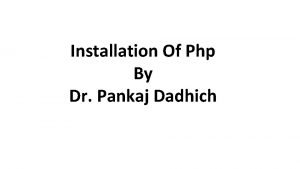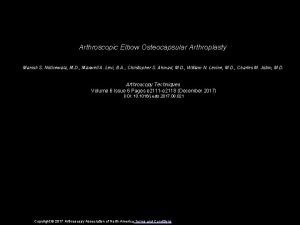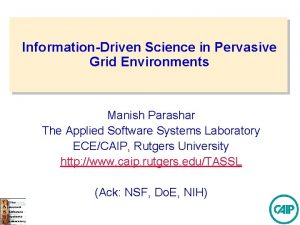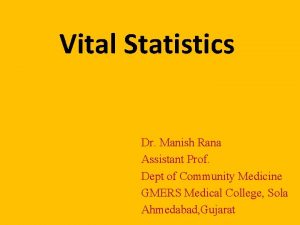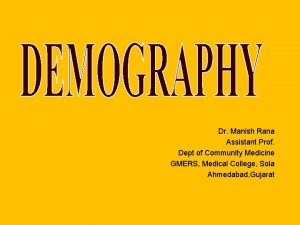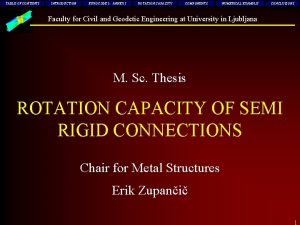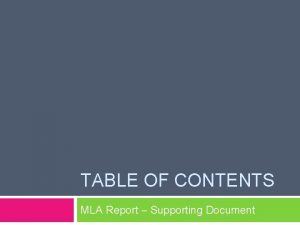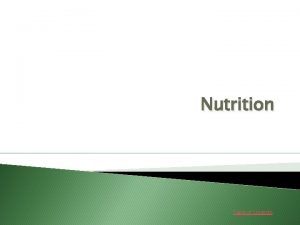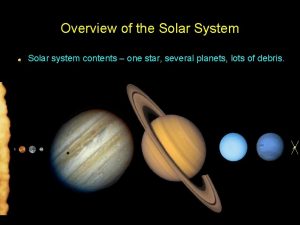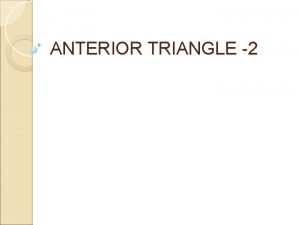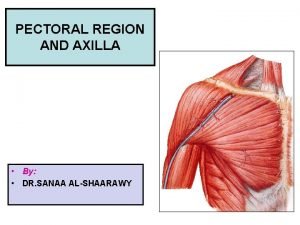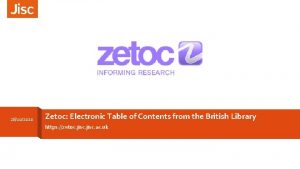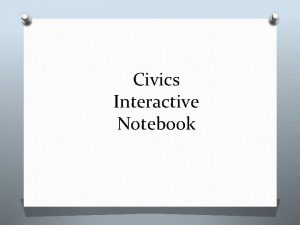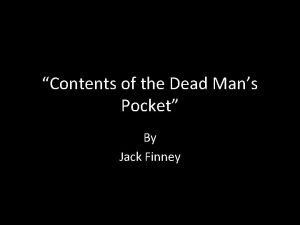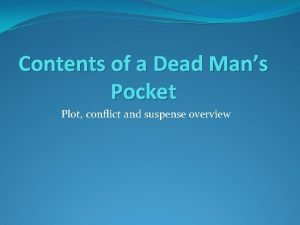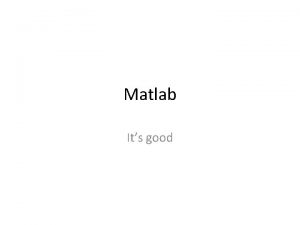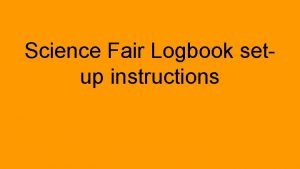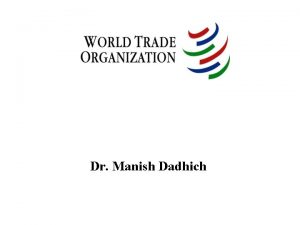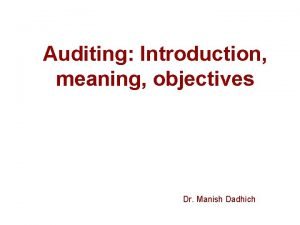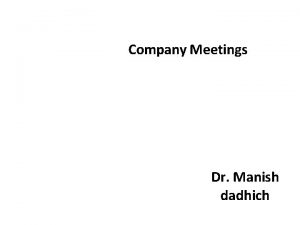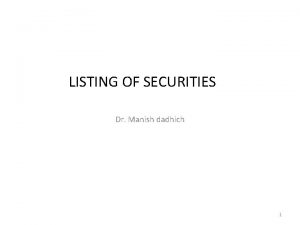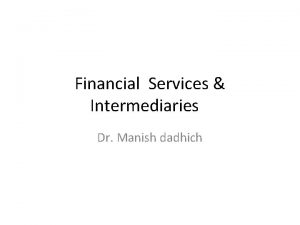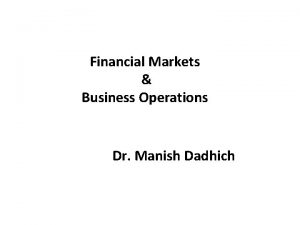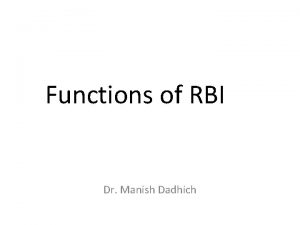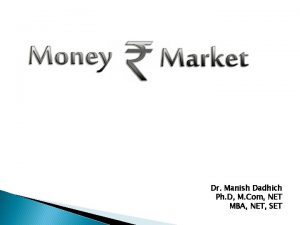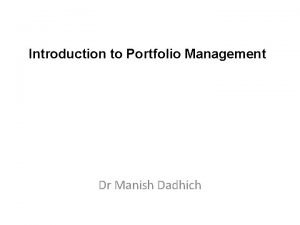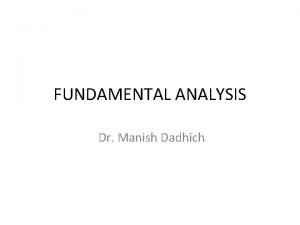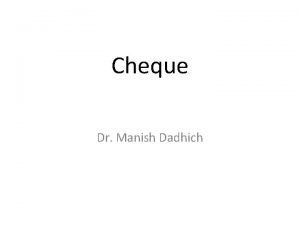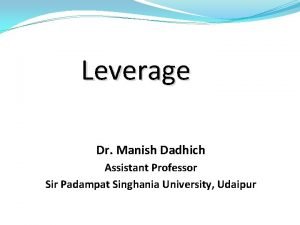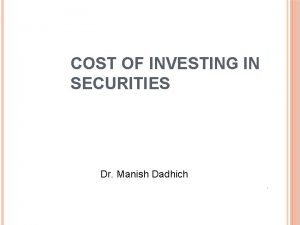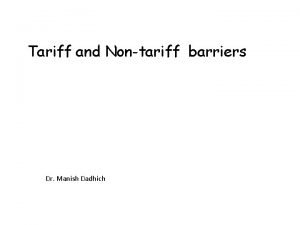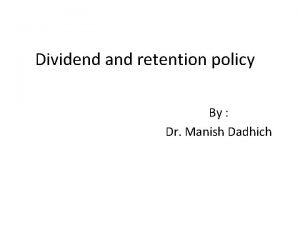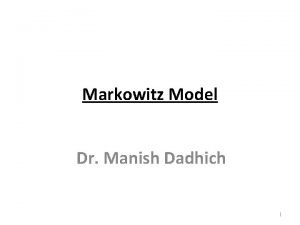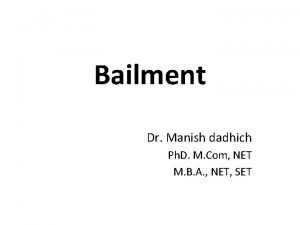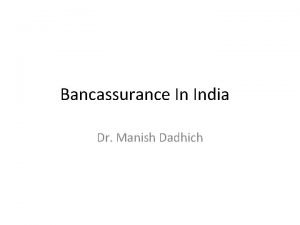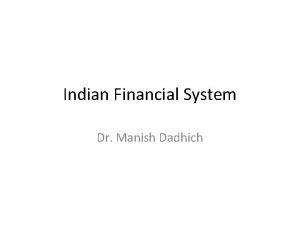Dr Manish Dadhich Contents To have an understanding

































- Slides: 33

Dr. Manish Dadhich

Contents • To have an understanding of WTO and the principles and functions of WTO • To study the structure of WTO • To study the role of WTO • To study the provision of TRIPs, TRIMs of WTO • To study role of WTO in developing countries • To study the current issues of WTO

What is the World Trade Organization? “The World Trade Organization is ‘member-driven’, with decisions taken by General agreement among all member of governments and it deals with the rules of trade between nations at a global or near-global level”

Formation 1 January 1995; 24 years ago Type International trade organization Purpose Reduction of tariffs and other barriers to trade Headquarters Centre William Rappard, Geneva, Switzerland Region served Worldwide Membership 164 member states Official language English, French, Spanish[ Director-General Roberto Azevêdo Budget 197. 2 million Swiss francs (approx. 209 million US$) in 2018. Staff 640 Website www. wto. org

They deal with: agriculture, textiles and clothing, banking, telecommunications, government purchases, industrial standards and product safety, food sanitation regulations, intellectual property, and much more. The WTO agreements are lengthy and complex because they are legal texts covering a wide range of activities.

WTO: The Beginnings/ History • The World Trade Organization (WTO) came into being on January 1 st 1995. It was the outcome of the lengthy (1986 -1994) Uruguay round of GATT negotiations. The WTO was essentially an extension of GATT. • It extended GATT in two major ways. First GATT became only one of the three major trade agreements that went into the WTO (the other two being the General Agreement on Trade in Services (GATS) and the agreements on Trade Related Aspects of Intellectual Property Rights (TRIPS)).

CONTI. . . • Second the WTO was put on a much sounder institutional footing than GATT. With GATT the support services that helped maintain the agreement had come into being in an ad hoc manner as the need arose. The WTO by contrast is a fully fledged institution (GATT also was, at least formally, only an agreement between contracting parties and had no independent existence of its own while the WTO is a corporate body recognized under international law).

TRIPS & TRIMs TRIPS also specifies enforcement procedures, remedies, and dispute resolution procedures. (TRIMs) are rules that apply to the domestic regulations a country applies to foreign investors, often as part of an industrial policy. The agreement was agreed upon by all members of the World Trade Organization. 1

WTO FACT The World Trade Organization is an inter governmental organization that regulates international trade. The WTO officially commenced on 1 January 1995 under the Marrakesh Agreement, signed by 124 nations on 15 April 1994, replacing the General Agreement on Tariffs and Trade, which commenced in 1948.

Why WTO? • To arrange the implementation, administration and operations of multilateral (involving three or more participants) and Plurilateral trade agreements (power which shared between different countries) • To arrange the forum for deliberations for the member nations in regard to their multilateral trade relations in issues deal with under the agreements

CONTI. . . • To provide a framework for implementing of the results arising out of the deliberations (long and care full agreements/consideration) which taken place at ministerial conference level • To manage the created understanding on rules and procedure governing the settlement of disputes

CONTI. . . • To manage effectively and efficiency the trade policy review mechanism (TRIM) • To create more together relationship with all nations in respect of global economic policymaking, it would cooperate with the IMF and the world bank & its affiliated Organisations.

Features of the WTO i. Unlike the GATT, it is a legal entity. ii. Unlike the International Monetary Fund (IMF) and the World Bank (WB) it is not an agent of the United Nations. iii. Unlike the IMF and the World Bank, there is no weighted voting, but all the WTO members have equal rights. iv. Unlike the GATT, the agreements under the WTO are permanent and binding to the member countries. v. Unlike the GATT, the WTO dispute settlement system is based not on dilatory but automatic mechanism. It is also quicker and binding on the members. As such, the WTO is a powerful body.

Features of the WTO vi. Unlike the GATT, the WTOs approach is rulebased and time-bound. vii. Unlike the GATT, the WTOs have a wider coverage. It covers trade in goods as well as services. viii. Unlike the GATT, the WTOs have a focus on trade-related aspects of intellectual property rights and several other issues of agreements. ix. Above all, the WTO is a huge organisational body with a large secretariat.

Objectives of the WTO To ensure the reduction of tariffs and other barriers to trade. 2. To eliminate discriminatory treatment in international trade relations. 3. To facilitate higher standards of living, full employment, a growing volume of real income and effective demand, and an increase in production and trade in goods and services of the member nations. 4. To make positive effect, which ensures developing countries, especially the least developed secure a level of share in the growth of international trade that reflects the needs of their economic development.

Objectives of the WTO 5. To facilitate the optimal use of the world’s resources for sustainable development. 6. To promote an integrated, more viable and durable trading system incorporating all the resolutions of the Uruguay Round’s multilateral trade negotiations. Above all, to ensure that linkages trade policies, environmental policies with sustainable growth and development are taken care of by the member countries in evolving a new economic order.

Functions of the WTO The WTO consisting a multi-faced normative framework: comprising institutional substantive and implementation aspects. The major functions of the WTO are as follows: 1. To lay-down a substantive code of conduct aiming at reducing trade barriers including tariffs and eliminating discrimination in international trade relations. 2. To provide the institutional framework for the administration of the substantive code which encompasses a spectrum of norms governing the conduct of member countries in the arena of global trade.

Functions of the WTO 3. To provide an integrated structure of the administration, thus, to facilitate the implementation, administration and fulfillment of the objectives of the WTO Agreement and other Multilateral Trade Agreements. 4. To ensure the implementation of the substantive code. 5. To act as a forum for the negotiation of further trade liberalisation. 6. To cooperate with the IMF and WB and its associates for establishing a coherence in trade policy-making. 7. To settle the trade-related disputes.

PRINCIPLES OF WTO The basic principles of the WTO (according to the WTO): • Trade Without Discrimination 1. Most-favoured-nation (MFN): treating other people equally under the WTO agreements, countries cannot normally discriminate between their trading partners. Grant someone a special favour (such as a lower customs duty rate for one of their products) and have to do the same for all other WTO members. 2. National treatment: Treating foreigners and locals equally Imported and locally-produced goods should be treated equally — at least after the foreign goods have entered the market. The same should apply to foreign and domestic services, and to foreign and local trademarks, copyrights and patents.

CONTI. . . • Freer trade: gradually, through negotiation Lowering trade barriers is one of the most obvious means of encouraging trade. The barriers concerned include customs duties (or tariffs) and measures such as import bans or quotas that restrict quantities selectively • Predictability: through binding and transparency Sometimes, promising not to raise a trade barrier can be as important as lowering one, because the promise gives businesses a clearer view of their future opportunities. With stability and predictability, investment is encouraged, jobs are created and consumers can fully enjoy the benefits of competition — choice and lower prices. The multilateral trading system is an attempt by governments to make the business environment stable and predictable.

CONTI. . . • Promoting fair competition The WTO is sometimes described as a “free trade” institution, but that is not entirely accurate. The system does allow tariffs and, in limited circumstances, other forms of protection. More accurately, it is a system of rules dedicated to open, fair and undistorted competition. • Encouraging development and economic reform. The WTO system contributes to development. On the other hand, developing countries need flexibility in the time they take to implement the system’s agreements. And the agreements themselves inherit the earlier provisions of GATT that allow for special assistance and trade concessions for developing countries.

STRUCTURES OF WTO Ministerial Conference Dispute Settlement Body The Committee on T&D and T&E General Council Goods Council Intellectual Property Council Trade Policy Review Body Services Council

Ministerial Conference At the top of the WTO structure is Ministerial conference (MC). It comprises of international trade ministers from all member countries. This governing body of WTO frames all strategic directions and takes all vital decisions on multilateral trade agreements. General Council (GC) General Council has senior representatives (generally ambassador level) from all member nations. Its job is to have a glance into day-to-day working and management of WTO. On the behalf of MC, General council is the decision making body. Large number of councils and committees report directly to GC.

Director General and Secretariat of WTO The secretariat is headed by the Director General (DG) by MC for a period of four years. It has no decision making power but secretariat provides administrative services and advise. Trade Dispute Settlement Body (DSB) WTO resolves all quarrels among member nations under Dispute Settlement Body. DSB ensures smooth functioning of multilateral trade agreements; and enforcement of rules and principles of WTO.

Trade Policy Review Body The body has all members of WTO and looks into the trade policy review mechanism. It regularly reviews the trade policies and practices of WTO members. It enhances transparency for better understanding of individual trade policies of each member nation.

WTO and India is a founder member of World Trade Organization and also treated as the part of developing countries group for accessing the concessions granted by the organization. As a result, there are several implications for India for the various agreements that are signed under WTO discussed as follows:

WTO and India (i) Reduction of Tariff and Non-Tariff Barriers: The agreement involves an overall reduction of peak and average tariffs on manufactured products and phasing out the quantitative restrictions over a period. The important implication is that the firms that have competitive advantage would be able to survive in the long run. (ii) Trade Related Investment Measures (TRIMS): The agreement prohibits the host country to discriminate the investment from abroad with domestic investment i. e. agreement requires investment to be freely allowed by nations.

(iii)Trade Related Intellectual Property Rights (TRIPS): An intellectual property right seeks to protect and provide legal recognition to the creator of the intangible illegal use of his creation. This agreement includes several categories of property such as Patents, Copyrights, Trademarks, Geographical indications, Designs, Industrial circuits and Trade secrets. Since the law for these intangibles vastly varied between countries, goods and services traded between countries which incorporated these intangibles faced severe risk of infringement.

(iv)Agreement on Agriculture (AOA): The agreement on agriculture broadly deals with providing market access, reduction of export subsidies and government subsidies on agriculture products by member countries. The reduction of tariffs and subsidy in export and import items would open up competition and provide a better access to Indian products abroad. (v) Agreement on Sanitary and psyto-sanitary measures (SPM): This agreement refers to restricting exports of a country that do not comply with the international standards of germs/bacteria etc. Since allowing such products inside the country, there would be spread of disease and pest in the importing country.

(vi) Multi-Fiber Agreement (MFA): This agreement is dismantled with effect from 1 January 2005. The result was removal of quantitative restrictions (QRs) on the textile imports in several European countries. As a consequence a huge textile market is opened up for developing countries like India. In order to take advantage of opening up better preparedness is required in terms of modernization, standardization, cost efficiency, and customization to meet challenges of foreign customers.

Conclusion: The Indian economy has experienced a major transformation as a result of the changing multilateral trade discipline within WTO framework. It is expected that the sectors such as textiles, clothing, leather and leather products, and food, beverages, and tobacco etc would experience growth in output and exports. However, there is a serious and urgent need to re-look the strategies followed by individual firms in the changing context of increasing competition and opened markets.

TRIMs, AND TRIPS OF WTO 1) Agreement on Trade-Related Investment Measures (TRIMs) • TRIMs refers to certain conditions or restrictions imposed by a governments in respect of foreign investment in the country • The agreement on TRIMs provides that no contracting party shall apply any TRIM which is inconsistent with the WTO Articles. 2)Agreement on Trade-Related Aspects of Intellectual Property Rights (TRIPS) • The Agreement on Trade Related Aspects of Intellectual Property Rights (TRIPS) is an international agreement administered by the World Trade Organization (WTO) that sets down minimum standards for many forms of intellectual property (IP) regulation as applied to nationals of other WTO Members

THANK YOU
 Dr pankaj dadhich
Dr pankaj dadhich 6e2111
6e2111 Manish chaudhary mathura
Manish chaudhary mathura Importance of equity
Importance of equity Manish chaudhary mathura
Manish chaudhary mathura Manish parashar utah
Manish parashar utah Dr manish rana
Dr manish rana Pyelomyotomy
Pyelomyotomy Manish gupta
Manish gupta Dr manish rana
Dr manish rana A cube has 6 faces and 8 vertices
A cube has 6 faces and 8 vertices Read the text below.
Read the text below. Table of contents annex
Table of contents annex Mla table of contents
Mla table of contents Food table of contents
Food table of contents Solar system contents
Solar system contents Table of contents scrapbook
Table of contents scrapbook Clovis unified transportation
Clovis unified transportation Posterior mediastinum contents
Posterior mediastinum contents Ascending pharyngeal artery
Ascending pharyngeal artery Table of contents slide
Table of contents slide Pectoral region
Pectoral region Zetoc
Zetoc Interactive notebook table of contents
Interactive notebook table of contents Ocr epq exemplar
Ocr epq exemplar Contents of a dead man's pocket conflict
Contents of a dead man's pocket conflict What nerve innervates the testicles
What nerve innervates the testicles Company profile table of contents
Company profile table of contents What is vo
What is vo Contents of the dead man's pocket plot diagram
Contents of the dead man's pocket plot diagram Parotidomasseteric fascia
Parotidomasseteric fascia Mediastinum vs pericardium
Mediastinum vs pericardium Matlab
Matlab Science fair logbook table of contents
Science fair logbook table of contents
